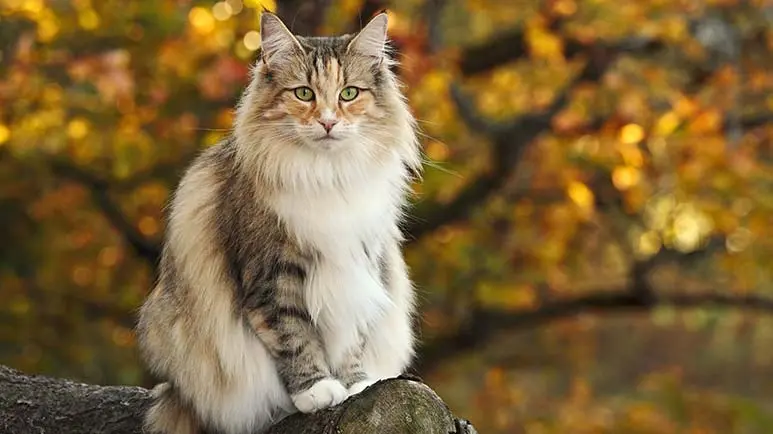Vikings Brought These Mystical Creatures Onboard Their Ships, and They’re Still Popular Today
Loving, gentle and sociable, these wonderful family pets with their intelligent gaze can grow as large as 22 pounds. Be prepared to be fascinated with these gorgeous, fluffy creatures, especially with their mystical triangular head shape. Have you ever seen one?

STORY AT-A-GLANCE
- Norwegian Forest cats have a mystical, legendary history and have been around since the Vikings took them onboard their longships as mousers centuries ago
- While they’re remarkably similar to Maine Coons with their long, thick and flowing fur, these felines have distinct features, including their triangular head shape
- As large as 22 pounds, Norwegian Forest cats are powerfully built with strong claws and an amazingly adroit ability to climb
- Friendly, loving and gentle, Norwegian Forest cats are also intelligent and sociable, which make them wonderful family pets
Editor's Note: This article is a reprint. It was originally published November 24, 2016.
Almost mythical with legendary status that is fascinating to today's cat lovers, the Norwegian Forest cat is frankly gorgeous, with an intelligent gaze and an incredible coat of thick, soft and fluffy fur.
That long, fluffy fur is one of their most striking features — dense and in a variety of shades, such as brown, cream, blue cream, tortoiseshell, cameo, red, gold, blue, black and white. Patterns range from tabby to calico markings, stripes, ticking and smoke.
While they're adorable to look at, they're undeniably regal, with a broad chest, powerful physique, long face and a huge ruff encircling their necks. The Cat Fanciers' Association (CFA) notes:
"If ever there was a cat built to match its environment, it is the Norwegian Forest Cat. It has developed over many years of natural selection into a breed able to survive the long harsh winters of Norway.
It is a sturdy cat with a double coat, which has protective, water-resistant guard hairs over a downy, warm undercoat.
The coats of the free-roaming cats do not mat because the loose hair resulting from their annual molt is removed by rubbing against such things as tree trunks and brambles. This type of coat is needed to survive the snows and moist, cold air in its native country."
Making them even more striking is their size, which is much larger than most other domestic cats and many smaller dogs. Males can weigh anywhere between 13 and 22 pounds. So what's the story on these beautiful animals?
Origins of the Norwegian Forest Cat
As mysterious as they are beautiful, the Norwegian Forest cat is a peculiar breed that has been around since the Vikings took them onboard their longships as mousers in the 1st century.
Norwegian legend recounts stories of the "skogkatt," meaning "forest cat," a "mountain-dwelling fairy cat with an ability to climb sheer rock faces that other cats could not manage."1 Today's breeders often refer to them as the "Norse skogkatt." "The Ultimate Cat Book" says:
"All that is certain about the Norwegian Forest Cat is that it is an old breed. Its ancestors may include shorthairs brought from Great Britain by the Vikings and longhaired cats brought by the Crusaders, which then mated with farm and feral stock."2
Freya, Norse goddess of love and beauty, whose favorite cat was this breed, was said to ride in a chariot drawn by cats. A common Norse fable involves Thor and Jormungand, a deity who won a contest of strength by impersonating a skogkatt.
This breed is as beloved in Norway as they've ever been, and around the world they're affectionately known as "Wegies" (with a long "e"), a nod to its Norwegian origins.
Purposeful Breeding May Have Saved the Breed
While the more modern skogkatts were also prized for their mousing skills, especially by farmers and sailors, over decades and centuries the breed was threatened by constant intermixing. Admirers of the breed didn't begin showing them until the 1930s, and by then it was almost too late.
By World War II, the Norwegian Forest cat breed nearly became extinct, as CFA3 reports:
"Norwegian Forest Cats were almost lost as a distinct breed through hybridization with the free-roaming domestic shorthairs in Norway. Interest was aroused among Norwegian cat fanciers when they realized that they were in real danger of losing the breed; but World War II put a hold on their efforts."
Finally, an intensive breeding program began to preserve the lineage, and the furry feline's distinct variety was officially recognized by the Fédération Internationale Féline (FIFe) in 1977. The first pair arrived in the States two years later, and in 1987 it was included in the CFA's catalog of breeds.
Besides being introduced for the first time in the show ring of bona fide cat breeds, the Norwegian Forest cat was also adopted by King Olaf V of Norway as the country's official feline.
Interesting Characteristics of the Norwegian Forest Cat
The Norwegian Forest cat bears a close resemblance to the Maine Coon breed, which, as it happens, is a distant descendant, but there are noticeable differences. The former has a wedge-shaped head and high cheekbones, while the featured kitty has a triangular-shaped head.
Another variation is the eye shape: the Norwegian Forest cat has almond-shaped eyes, while the Maine Coon's eyes are typically more round. The Norwegian matures slowly over about five years before reaching its peak size.
One notable feature is that its front legs are slightly longer than the back legs; all four are powerfully muscled and tufted with long "toe feathers," as are their ears. Their thick, winter coat is shed every spring resulting in six months of a noticeably thinner coat.
It's a tree climber, as most cats are, but this one tends to descend head first as opposed to the direction it went up. That's because of their claws; if claws can be brawny, these are — long, thick and sharp.
Personality Traits — One of the Norwegian Forest Cat’s Best Features
You'll hear many cat enthusiasts talk about cats with "personality." Vet Street describes Norwegian Forest cats as friendly, loving and gentle, with a "strong nurturing instinct."
"He might have the words 'forest cat' in his name, but the Wegie is far from feral. He loves people, in a low-key, cool Norwegian kind of way. He won't harass you for attention — unless his meals are late — but he will follow you around and hang out wherever you are."4
It's probably no surprise to find these cats are very smart and enjoy attention, which may be one reason they're so easily trained to perform tricks, such as fetching and figuring out puzzle toys.
These kitties will also converse with you, purring and chirping to let you know they're engaged and maybe even trying to communicate their needs. Like the best cats we know, they enjoy being around the people who love them, including gentle, respectful children.
Health Proclivities of the ‘Wegie’
Like other cats who end up with health problems, this one is not immune, but only a few have been noted in particular, Vet Street says; three of them in particular:
- Hypertrophic cardiomyopathy is a common heart ailment in cats, evidenced by thickening in the heart muscle. An echocardiogram can determine if this might be a problem.
- Hip dysplasia is a hereditary disease in many animals, including cats. It can be mild or debilitating, and possibly detected if your kitty begins moving slowly, is hesitant to jump or begins losing weight.
- Glycogen storage disease type IV can show up when kittens are newborns, but usually by 4 or 5 months old. A deficiency of an essential enzyme that metabolizes glycogen can cause impaired glycogen to build up in the animal's nerves and muscles. While it's fatal, it's also rare.
If you're looking for one of these unique beauties contact breed-specific rescues.
Sources and References
- 1,2 The Ultimate Cat Book pg. 76 Simon & Schuster
- 3 CFA 1995-2016
- 4 Vet Street 2001-2016










